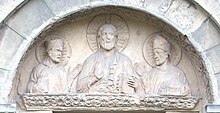Epiphanius of Pavia

Epiphanius of Pavia (* 439 in Pavia ; † January 21, 496 ibid) was bishop of Pavia from 466 until his death and is a saint of the Catholic Church .
Life
Its significance lies in the political role it played in the transition from the crumbling Western Roman Empire to the new Ostrogothic kingdom and in the violent conflicts of the time. Both the penultimate Western Roman emperor Julius Nepos and the Ostrogoth king Theodoric commissioned him as ambassador for important negotiations. He repeatedly succeeded in reaching agreements and reconciliations of interests that benefited the population, and averted or mitigated damage. In doing so, the authority of the Catholic Church as an institution independent of the state and ethnic groups worked together with his personal strength of character.
Even his pupil, successor in office and biographer Ennodius von Pavia describes Epiphanius as a saint. His grave soon became a place of pilgrimage. Numerous healing miracles have been attributed to him.
In 963, the greater part of the Epiphanius relics came to Hildesheim through Bishop Othwin . Tradition describes this translation as an adventurous predatory story. Historically, it belongs to the framework of numerous parallel reliquary transfers, often also stylized as theft, from Italy to the north of the empire , where the mission churches and newly founded dioceses sought heavenly helpers and earthly prestige. To portray such a conviction as a robbery that was successful under the most difficult conditions underlined the consent and cooperation of the saint concerned.
About a third of the bones and the head remained in Pavia in the church dedicated to the saint, which belonged to a collegiate monastery. After its dissolution, they came to the neighboring church of San Francesco Grande , where they are now kept under the high altar. The Epiphany relics acquired by Bishop Othwin rest in Hildesheim Cathedral together with those of other old diocesan patrons in a gilded shrine from the first half of the 12th century; From 1960 to 2010 it stood under the main altar hall and since 2014 has been exhibited on a gallery in the east wall of the northern arm of the transept.
From the connection through St. Epiphanius is a town twinning between Hildesheim and Pavia.
The feast day of St. Epiphanius is January 21st, in Hildesheim the 22nd January .
literature
- Friedrich Wilhelm Bautz : Epiphanius, Bishop of Pavia. In: Biographisch-Bibliographisches Kirchenlexikon (BBKL). Volume 1, Bautz, Hamm 1975. 2nd, unchanged edition Hamm 1990, ISBN 3-88309-013-1 , Sp. 1520-1521.
- Forester: Epiphanius, Bishop of Ticium (Pavia) . In: Realencyklopadie for Protestant Theology and Church (RE). 3. Edition. Volume 5, Hinrichs, Leipzig 1898, pp. 421-422.
- Bernhard Gallistl: Epiphanius von Pavia, patron saint of the Hildesheim diocese , Hildesheim 2000
- Bernhard Gallistl: A new text find on the Translatio S. Epiphanii in the Hildesheim Cathedral Library . In: Yearbook for History and Art in the Diocese of Hildesheim 74 (2006) pp. 123–152; -
- Martina Giese: The Transitus sancti Epiphanii and the Translatio sancti Epiphanii. New manuscript finds , DA 64/2 (2008) pp. 519–546
- Elisabeth Hermann-Otto: The social and political activities of Saint Epiphanius, bishop of Pavia . In: Studia Patristica 29. Leuven 1997, 46-51.
- Adolf Jülicher : Epiphanios 4 . In: Paulys Realencyclopadie der classischen Antiquity Science (RE). Volume VI, 1, Stuttgart 1907, Col. 194 f.
Web links
| personal data | |
|---|---|
| SURNAME | Epiphanius of Pavia |
| BRIEF DESCRIPTION | Catholic bishop and saint |
| DATE OF BIRTH | 439 |
| PLACE OF BIRTH | Pavia |
| DATE OF DEATH | January 21, 496 |
| Place of death | Pavia , Lombardy |